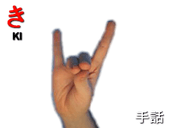Ki (kana)
き, in hiragana, キ in katakana, is one of the Japanese kana, which each represent one mora. Both represent [ki] and are derived from a simplification of the 幾 kanji. The hiragana character き, like さ, is drawn with the lower line either connected or disconnected.
| ki | ||||
|---|---|---|---|---|
| ||||
| transliteration | ki き | |||
| translit. with dakuten | gi ぎ | |||
| translit. with handakuten | (ngi) | |||
| hiragana origin | 幾 | |||
| katakana origin | 幾 | |||
| spelling kana | 切手のキ (Kitte no "ki") | |||
| kana gojūon | ||||||||||||||||||||||||||||||||||||||||||||||||||
|---|---|---|---|---|---|---|---|---|---|---|---|---|---|---|---|---|---|---|---|---|---|---|---|---|---|---|---|---|---|---|---|---|---|---|---|---|---|---|---|---|---|---|---|---|---|---|---|---|---|---|
|
||||||||||||||||||||||||||||||||||||||||||||||||||
A dakuten may be added to the character; this transforms it into ぎ in hiragana, ギ in katakana, and gi in Hepburn romanization. The phonetic value also changes, to [ɡi] in initial, and varying between [ŋi] and [ɣi] in the middle of words.
A handakuten (゜) does not occur with ki in normal Japanese text, but it may be used by linguists to indicate a nasal pronunciation [ŋi].
| Form | Rōmaji | Hiragana | Katakana |
|---|---|---|---|
| Normal k- (か行 ka-gyō) |
ki | き | キ |
| kī | きい きー |
キイ キー | |
| Addition yōon ky- (きゃ行 kya-gyō) |
kya | きゃ | キャ |
| kyā | きゃあ きゃー |
キャア キャー | |
| kyu | きゅ | キュ | |
| kyū | きゅう きゅー |
キュウ キュー | |
| kyo | きょ | キョ | |
| kyō | きょう きょお きょー |
キョウ キョオ キョー | |
| Addition dakuten g- (が行 ga-gyō) |
gi | ぎ | ギ |
| gī | ぎい ぎー |
ギイ ギー | |
| Addition yōon and dakuten gy- (ぎゃ行 gya-gyō) |
gya | ぎゃ | ギャ |
| gyā | ぎゃあ ぎゃー |
ギャア ギャー | |
| gyu | ぎゅ | ギュ | |
| gyū | ぎゅう ぎゅー |
ギュウ ギュー | |
| gyo | ぎょ | ギョ | |
| gyō | ぎょう ぎょお ぎょー |
ギョウ ギョオ ギョー |
| Other additional forms | |||||||||||||||||||
|---|---|---|---|---|---|---|---|---|---|---|---|---|---|---|---|---|---|---|---|
|
| ||||||||||||||||||
Stroke order
 Stroke order in writing き |
 Stroke order in writing キ |

Stroke order in writing き

Stroke order in writing キ
Other communicative representations
| Japanese radiotelephony alphabet | Wabun code |
| 切手のキ Kitte no "Ki" |
|
|
 |
 | |
| Japanese Navy Signal Flag | Japanese semaphore | Japanese manual syllabary (fingerspelling) | Braille dots-126 Japanese Braille |
- Full Braille representation
| き / キ in Japanese Braille | K + Yōon braille | ||||||
|---|---|---|---|---|---|---|---|
| き / キ ki |
ぎ / ギ gi |
きい / キー kī |
ぎい / ギー gī |
きゃ / キャ kya |
ぎゃ / ギャ gya |
きゃあ / キャー kyā |
ぎゃあ / ギャー gyā |
| K + Yōon braille | |||||||
| きゅ / キュ kyu |
ぎゅ / ギュ gyu |
きゅう / キュー kyū |
ぎゅう / ギュー gyū |
きょ / キョ kyo |
ぎょ / ギョ gyo |
きょう / キョー kyō |
ぎょう / ギョー gyō |
| Preview | き | キ | キ | ぎ | ギ | |||||
|---|---|---|---|---|---|---|---|---|---|---|
| Unicode name | HIRAGANA LETTER KI | KATAKANA LETTER KI | HALFWIDTH KATAKANA LETTER KI | HIRAGANA LETTER GI | KATAKANA LETTER GI | |||||
| Encodings | decimal | hex | decimal | hex | decimal | hex | decimal | hex | decimal | hex |
| Unicode | 12365 | U+304D | 12461 | U+30AD | 65399 | U+FF77 | 12366 | U+304E | 12462 | U+30AE |
| UTF-8 | 227 129 141 | E3 81 8D | 227 130 173 | E3 82 AD | 239 189 183 | EF BD B7 | 227 129 142 | E3 81 8E | 227 130 174 | E3 82 AE |
| Numeric character reference | き | き | キ | キ | キ | キ | ぎ | ぎ | ギ | ギ |
| Shift JIS[1] | 130 171 | 82 AB | 131 76 | 83 4C | 183 | B7 | 130 172 | 82 AC | 131 77 | 83 4D |
| EUC-JP[2] | 164 173 | A4 AD | 165 173 | A5 AD | 142 183 | 8E B7 | 164 174 | A4 AE | 165 174 | A5 AE |
| GB 18030[3] | 164 173 | A4 AD | 165 173 | A5 AD | 132 49 151 57 | 84 31 97 39 | 164 174 | A4 AE | 165 174 | A5 AE |
| EUC-KR[4] / UHC[5] | 170 173 | AA AD | 171 173 | AB AD | 170 174 | AA AE | 171 174 | AB AE | ||
| Big5 (non-ETEN kana)[6] | 198 177 | C6 B1 | 199 69 | C7 45 | 198 178 | C6 B2 | 199 70 | C7 46 | ||
| Big5 (ETEN / HKSCS)[7] | 198 243 | C6 F3 | 199 169 | C7 A9 | 198 244 | C6 F4 | 199 170 | C7 AA | ||
| Preview | き゚ | キ゚ | ||
|---|---|---|---|---|
| Unicode name | HIRAGANA LETTER BIDAKUON NGI[8] | KATAKANA LETTER BIDAKUON NGI[8] | ||
| Encodings | decimal | hex | decimal | hex |
| Unicode | 12365 12442 | U+304D+309A | 12461 12442 | U+30AD+309A |
| UTF-8 | 227 129 141 227 130 154 | E3 81 8D E3 82 9A | 227 130 173 227 130 154 | E3 82 AD E3 82 9A |
| Numeric character reference | き | き | キ | キ |
| Shift JIS-2004[9] | 130 246 | 82 F6 | 131 152 | 83 98 |
| EUC-JIS-2004[10] | 164 248 | A4 F8 | 165 248 | A5 F8 |
gollark: Just missing the GNU bit, like the Alpine install on my server.
gollark: Android is *Linux*.
gollark: The PinePhone will possibly be able to run Android apps via an emulator.
gollark: To be fair though, the actual apps aren't electron, they're... react native?
gollark: i. e. a bloated browser with some native interfaces.
References
- Unicode Consortium (2015-12-02) [1994-03-08]. "Shift-JIS to Unicode".
- Unicode Consortium; IBM. "EUC-JP-2007". International Components for Unicode.
- Standardization Administration of China (SAC) (2005-11-18). GB 18030-2005: Information Technology—Chinese coded character set.
- Unicode Consortium; IBM. "IBM-970". International Components for Unicode.
- Steele, Shawn (2000). "cp949 to Unicode table". Microsoft / Unicode Consortium.
- Unicode Consortium (2015-12-02) [1994-02-11]. "BIG5 to Unicode table (complete)".
- van Kesteren, Anne. "big5". Encoding Standard. WHATWG.
- Unicode Consortium. "Unicode Named Character Sequences". Unicode Character Database.
- Project X0213 (2009-05-03). "Shift_JIS-2004 (JIS X 0213:2004 Appendix 1) vs Unicode mapping table".
- Project X0213 (2009-05-03). "EUC-JIS-2004 (JIS X 0213:2004 Appendix 3) vs Unicode mapping table".
This article is issued from Wikipedia. The text is licensed under Creative Commons - Attribution - Sharealike. Additional terms may apply for the media files.

